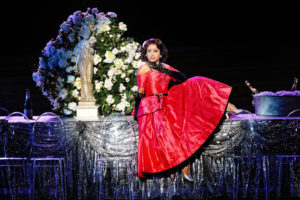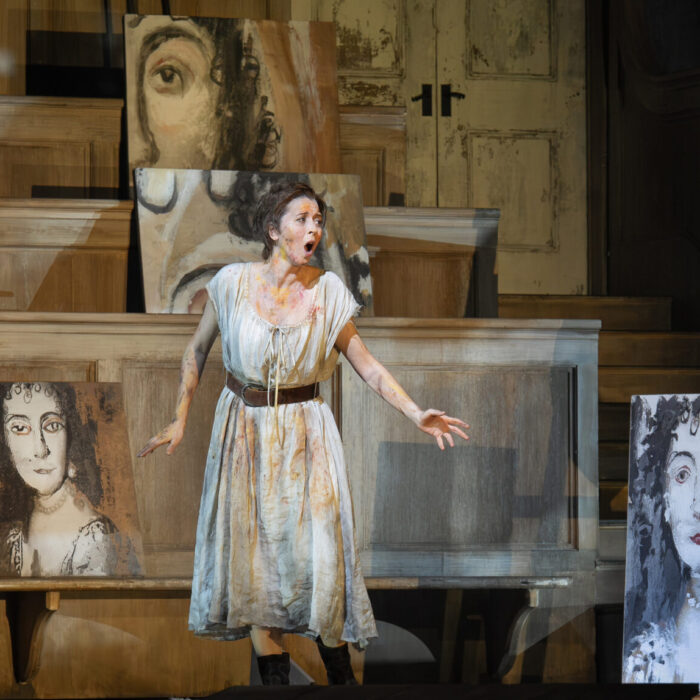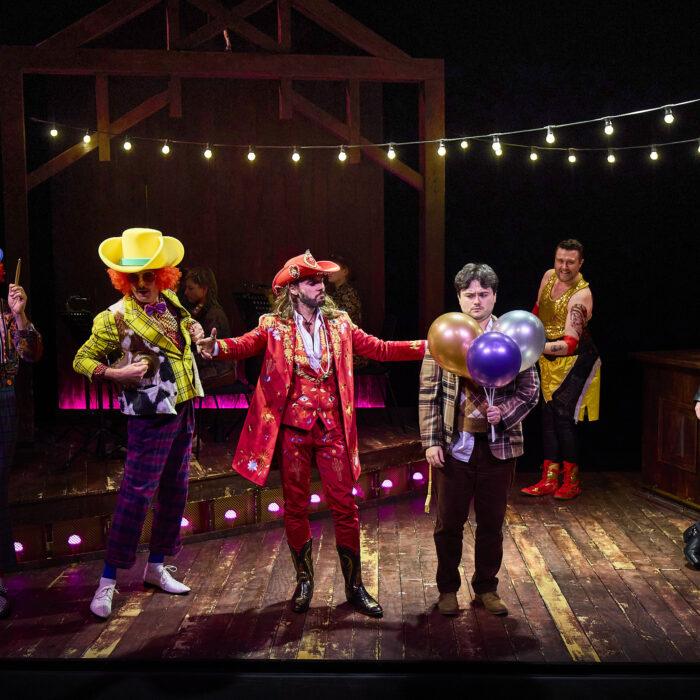
Opera Australia 2021 Review: La Traviata
A Successful Rendition of Verdi’s Masterwork that Kept the Focus Onstage Instead of its Harbor Setting
By Gordon WilliamsOpera Australia’s annual Handa Opera on Sydney Harbour returned this year after last year’s Covid-enforced hiatus with a re-staging by Constantine Costi of the production of “La Traviata” by Francesca Zambello which, back in 2012, launched this Sydney institution.
How a venue brings out different qualities in a familiar work is one of the fascinating aspects of theatrical performance traditions. Arguably, you couldn’t get a more spectacular venue for a performance than this outdoor arena temporarily situated on the eastern side of Farm Cove across the bay from the famed Opera House. But how does it affect an opera like Verdi’s “La Traviata,” which depicts the intimate side of the life of the “Traviata” – Violetta and the threat of her mortal illness–as much as her life of luxury?
The Chandelier Headlines Production
Perhaps by amplifying the extroverted aspects so much that the “interior” scenes are moving by comparison. Set designer Brian Thomson’s 3.5 tonne chandelier sparkling with 10,000 crystals is deservedly a talking point and one of the production features that keeps the eye from wandering during the performance to the distant Sydney Opera House off to the right. That chandelier is really the most important design feature that lends a sense of reality to the setting, the forced joyfulness of the doomed demi-monde Violetta’s lifestyle.
But then there are other, equally-evocative, identifiers: the “neon” silhouettes of Paris landmarks, including Sacré Coeur, the Moulin Rouge, and the Eiffel Tower, circa 1950, the period in which this production is set. So simple and yet so effective. Similarly powerful are Tess Schofield’s colorful costumes, particularly underlining the spirit-raising effect of the Act Two Scene Two dance numbers.
Dividing the opera with a single interval at the end of Act Two Scene One, which is always a possibility, was particularly smart under these circumstances, and it gave each “half” a downward slide, from party to tragedy, in keeping with the opera’s overall contour. An extra-long interval probably gave the chorus the additional time needed to board a “party boat”’ which came around Mrs. Macquarie’s Point, caught in the beam of a strong spotlight, at the beginning of Act two and berthed on the pontoon bridge backstage.
In addition to environmental considerations there was a fantastic use of the floating performance area “more than twice the size of any Australian indoor stage,” tipped up slightly–that is, raked–to maximize audience-view, and capable of supporting 150 tonnes. Dance sequences, in this production choreographed by Shannon Burns, made sense as an essential part of the story. The foot-stamping of the ensemble at the end of Scene one magnified the impression of ‘skol, skol’ hedonism. And though Opera Australia’s publicity boast that ‘”fireworks light up the sky at every performance” may have at first appeared a concession to a favorite Sydney pastime–watching harbor fireworks–it was again part of this production’s emphasizing of the doomed high-spiritedness of Violetta.
Particularly affecting however was the pantomime that accompanied the opening prelude. Verdi’s poignant chorale on high strings emerged from under the stage, from a studio where the orchestra was located, and a small figure came up over the back steps. She was in a festive red dress but looked forlorn in that space. As Verdi’s prelude became more animated with swifter-moving music, the stage was gradually peopled with partygoers dancing in a stylized 1950s fashion; a physical counterpoint to the music. The whole scene had the feel of a reminiscence. And then Violetta–she in the red dress–coughed. Jumping back to the present and we knew she was going to die.
Finding a Balance
Performing in such a large space outdoors no doubt risked musical problems: how to keep in time, how to keep in tune. From this point of view the production was secure. The onstage performers watched the conductor, Brian Castles-Onion, on a video screen, and in-ear monitors ensured that the singers could hear the orchestra in their ‘underworld’, as the orchestral space beneath the stage is called. Yet despite the fact that the volume seemed occasionally a smidge too loud and the tone lacking the warmth of an indoor acoustic, there were musical highlights to enjoy.
First among these was Australian-Mauritian soprano Stacey Alleaume’s detailed portrayal of Violetta, ranging from the ringing of her spectacular top-notes signifying disease-denying festiveness to the rasping bitterness of her “E tardi” (Too late) when she read of her abandoned lover Alfredo’s return half an hour before her imminent death.
As Alfredo Germont the Kosovar tenor Rame Lahaj perfectly conveyed the naiveté of a very young man who would fall heedlessly in love with a society woman, oblivious of the extent to which she lives off the generosity and sexual needs of wealthy benefactors. His duet with Alleaume towards the end of the opera, when they are trying to delude themselves into re-imagining a happy future in Paris (“Parigi, o cara“), was striking in the contrast of vocal color between them: Alleaume clearly conveyed the ravages of a mortal disease as Lahaj bloomed in oblivious full health.
As Germont Senior, Alfredo’s father, Michael Honeyman’s solo “Di Provenza il mar,” when he tries to reconcile Alfredo to the necessity of ending his relationship with Violetta, was extremely affecting. It was also so poignant at the end of Act two, Scene two when, after persuading Violetta to give up Alfredo for the sake of his son’s social reputation, he sat on the couch with her, realizing the inherent nobility of her character.
Here was an issue that may have arisen because of the particular nature of this production’s setting, though; the arena dimensions of the stage worked against the close-up focus that may have helped that big Act Two, Scene two accomplish finer gradations of persuasion and reflection on Germont’s part, and acceptance on Violetta’s. On the other hand, a big number, the Act two, Scene two ensemble finale, at Violetta’s final party, became beautifully ironic as never before. How a venue brings out different qualities in a familiar work!
Verdi scored his mid-career operas extremely quickly. He may have spent months on the libretto with his collaborators but could orchestrate in a matter of weeks. And yet, there are subtleties in “La Traviata” to listen out for. Conductor Brian Castles-Onion managed this project superbly. In fact, the poignant woodwind gilding of certain phrases was more noticeable than on other occasions.
The success of this production is probably to be gauged by how deeply it managed to be moving despite the temptation to give in to a feeling of “pleasant night by the harbor.” The ramping up of the opera’s festive elements has been mentioned: they acquired a sense of irony. Violetta came across as defiant, not pathetic. We didn’t so much witness the ravaging of someone who was once the life of the party but instead the life-of-the-party’s race against death, and that is undeniably one of the opera’s readings, even if it was prompted here in part by the outdoor setting.



